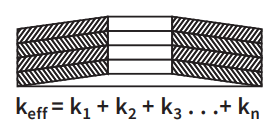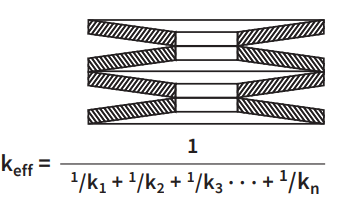How do you calculate rate/loads for disc spring stacks?
The effective spring rate of a stack of spring washers depends on the orientation of the stack. If Belleville spring washers are stacked so that they nest together (i.e. stacked like paper cups), they are said to be in “parallel” with each other. When a stack of springs in parallel is deflected, all of the springs in the stack deflect as much as the total stack deflection. The effective spring rate for spring washers in parallel is simply the sum of the individual spring washer rates. This is an effective way of achieving very high force output in very limited operating space. For a stack of n spring washers in parallel, the effective spring rate is calculated using the following equation.

If spring washers are stacked such that they meet O.D.-to-O.D. and I.D.-to-I.D., the stack is said to be in “series”. In this case, the deflection of the stack is distributed between all of the springs in the stack. The effective spring rate for the stack is lower than the softest individual spring rate in the stack. This is an effective means of gaining available deflection in limited operating space. For a stack of n spring washers in series, the effective spring rate is calculated using the following equation.

In cases where spring washers are stacked in a combination of series and parallel, calculate the effective rates for segments of the stack in series and then calculate the entire stack as a parallel stack considering the series segments as single springs with their respective effective spring rates.